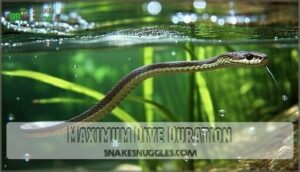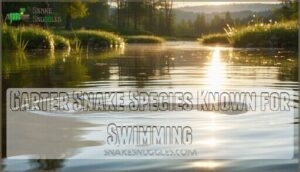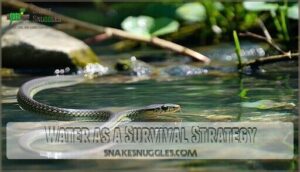This site is supported by our readers. We may earn a commission, at no cost to you, if you purchase through links.

They’re actually among North America’s most skilled aquatic serpents, using their swimming abilities to hunt fish, frogs, and other water-dwelling prey. When threatened, they’ll quickly slip into nearby streams or ponds to escape predators.
Their muscular bodies work like natural propellers, pushing them through water with surprising speed and grace. Unlike many land snakes, garter snakes can even hold their breath underwater for extended periods while diving for food.
Their aquatic skills reveal fascinating adaptations you might never have expected, showcasing how garter snakes are well-equipped to thrive in both water and on land, making them highly adaptable reptiles.
Table Of Contents
- Key Takeaways
- Garter Snakes and Their Aquatic Abilities
- How Well Can Garter Snakes Swim?
- Underwater Breathing and Diving Capabilities
- Aquatic Hunting Behaviors
- Garter Snake Species Known for Swimming
- Water as a Survival Strategy
- Comparing Garter Snakes to Other Aquatic Snakes
- Garter Snakes in Different Water Environments
- Impact of Swimming Ability on Garter Snake Distribution
- Observing Garter Snakes in Aquatic Habitats
- Frequently Asked Questions (FAQs)
- Where do garter snakes live?
- Can garter snakes swim?
- Are aquatic garter snakes ovoviviparous?
- What is an aquatic garter snake?
- How do garter snakes survive?
- Is a garter snake a seasnake?
- Do garter snakes like to be in water?
- How long can garter snakes stay underwater?
- Do common garter snakes swim?
- How aggressive are garter snakes?
- Conclusion
Key Takeaways
- You’ll find garter snakes are naturally excellent swimmers who use their streamlined bodies and S-shaped movements to glide through water with surprising speed and grace.
- They can hold their breath underwater for 10-30 minutes while diving to hunt fish, frogs, and other aquatic prey, making them skilled underwater predators.
- Swimming serves as their primary escape strategy when threatened by predators like hawks or foxes, allowing them to quickly disappear into nearby streams or ponds for safety.
- Their aquatic abilities directly influence where they live across North America, as they strategically choose habitats near water sources like streams, ponds, and marshes to maximize hunting opportunities and survival advantages.
Garter Snakes and Their Aquatic Abilities
You might be surprised to learn that garter snakes are skilled swimmers, thanks to their streamlined bodies and powerful muscles.
Their natural habitat often includes ponds and streams, where these aquatic abilities help them hunt, escape predators, and regulate body temperature, making them well-adapted to their environment.
Natural Habitat
You’ll discover garter snakes thriving in diverse water sources across North America’s geographic range.
These adaptable reptiles choose habitat diversity strategically:
- Shallow streams with rocky bottoms
- Tranquil ponds and marshes
- Wooded hillsides near creeks
- Grassy plains with seasonal wetlands
- Urban gardens with water features
Their garter snake habitat preferences maintain ecosystem balance while supporting varied land use patterns.
Adaptations for Swimming
Garter snakes’ streamlined bodies and powerful tail propulsion make them natural swimmers.
Their aquatic vision adapts to underwater hunting, while specialized buoyancy control helps them navigate depths.
These snakes don’t have webbed scales, but their muscular design creates efficient water movement.
Their aquatic adaptations include oxygen conservation techniques and sensory modifications for detecting prey underwater.
These swimming abilities showcase remarkable snake aquatic behavior evolution.
Understanding proper garter snake care is essential for their overall health and well-being.
How Well Can Garter Snakes Swim?
You’ll be amazed at how well garter snakes can swim – they’re natural aquatic athletes with impressive skills.
These remarkable reptiles use a graceful S-shaped motion to glide through water with surprising speed and agility, making them natural aquatic athletes.
Swimming Techniques
When garter snakes enter water, they use lateral undulation to move efficiently through aquatic environments.
Their swimming techniques showcase remarkable adaptations:
- Stroke Patterns: S-shaped waves push against water for propulsion
- Body Flex: Alternating muscle contractions create sinusoidal motion
- Water Entry: Smooth surface swimming with occasional submersion
- Dive Depths: Brief underwater forays for hunting or escape
- Propulsion Methods: Trunk musculature drives limbless locomotion
These snake aquatic behaviors demonstrate their natural swim ability in various aquatic environments.
Speed and Agility in Water
Through swift, undulating movements, these serpents demonstrate remarkable swimming speed and water maneuverability.
Their streamlined bodies and powerful muscles create impressive aquatic locomotion, allowing them to navigate currents with surprising underwater agility.
Aquatic reflexes help them execute sharp turns and quick escapes.
While garter snakes use effective snake swimming technique and dive techniques, their snake water speed varies by species, with some reaching impressive velocities that showcase their natural snake swimming skills in aquatic environments.
Underwater Breathing and Diving Capabilities
You’ve probably wondered how long garter snakes can hold their breath when they disappear underwater while hunting or escaping danger.
These remarkable reptiles have developed special breathing techniques that allow them to stay submerged for 10-30 minutes, depending on the species and water temperature.
Respiratory Adaptations
You won’t believe how garter snakes master underwater breathing without gills.
These remarkable reptiles employ metabolic slowdown techniques, dramatically reducing their oxygen demands during submersion.
Through specialized skin absorption, they can extract dissolved oxygen directly from water – a clever respiratory adaptation that extends their dive duration.
This oxygen conservation strategy, combined with reduced heart rates and breathholding abilities, transforms them into surprisingly capable aquatic hunters who can outlast many expectations.
Maximum Dive Duration
Aquatic champions like garter snakes possess remarkable dive limits that’ll amaze you.
These serpentine athletes demonstrate exceptional breath control underwater, with maximum dive duration reaching impressive heights.
Their diving capabilities showcase nature’s engineering brilliance through specialized submersion tactics.
Here’s what makes their underwater breathing extraordinary:
- Dive times extend up to 30 minutes in ideal conditions
- Cooler water pressure environments boost endurance by 40%
- Larger snakes outperform juveniles in snake swim ability
- Stress can halve typical submersion periods
- Garter snake swimming varies dramatically between species
Most dives last under 10 minutes, though some impressive individuals break records completely.
Aquatic Hunting Behaviors
When you watch a garter snake in water, you’ll notice it’s not just swimming for fun – it’s actively hunting for its next meal.
These skilled aquatic predators use specialized techniques to catch fish, frogs, and other water-dwelling creatures with remarkable precision.
Prey Selection in Water
When you watch these skilled hunters in aquatic prey environments, you’ll notice their selective fish hunting approach.
Garter snakes target amphibians, small fish, and aquatic invertebrates using specialized water tactics.
Their snake foraging focuses on species they can overpower—tadpoles, frogs, and salamanders make up 80-90% of their diet.
This precise prey selection in underwater feeding scenarios showcases remarkable aquatic hunting abilities, with their snake swim ability enabling efficient water snakes behavior through strategic snake water movement.
Hunting Strategies
Garter snakes become skilled predators once they enter water.
You’ll observe them using ambush tactics, lying motionless among vegetation before striking with remarkable speed.
Their foraging strategies include both active pursuit and patient waiting.
These reptiles can hold their breath for 10-15 minutes, allowing extended aquatic pursuits.
Some juveniles even use tongue-flicking to mimic insects, luring fish within striking distance.
Their hunting techniques adapt perfectly to different water environments.
Garter Snake Species Known for Swimming
You’ll find that not all garter snake species are equally skilled swimmers, though most can handle water when needed.
Two species stand out as true aquatic champions: the Common Garter Snake and the specialized Aquatic Garter Snake.
Common Garter Snake
While aquatic hunting behaviors showcase impressive underwater skills, common garter snakes (Thamnophis sirtalis) stand out as nature’s versatile swimmers.
You’ll find these adaptable reptiles thriving in diverse water environments, from backyard ponds to rushing streams. Their snake water agility and natural buoyancy water abilities make them formidable aquatic predators.
Key swimming capabilities include:
- Snake water locomotion using S-shaped undulation for efficient propulsion
- Garter snake water survival techniques allowing 10-15 minute submersion periods
- Snake behavior adaptations for both ambush and pursuit hunting underwater
- Garter diet expansion to include fish, tadpoles, and aquatic invertebrates
- Snake camouflage skills helping them blend with underwater vegetation and shadows
The unique characteristics of garter snakes, such as their species profile, play a significant role in their ability to thrive in various aquatic environments.
Aquatic Garter Snake
While common garter snakes can swim well, the aquatic garter snake truly masters water navigation.
These specialists inhabit western wetlands, displaying remarkable aquatic reflexes and snake buoyancy that lets them hunt underwater for extended periods.
Their streamlined bodies show perfect snake water locomotion, using how snakes swim techniques to catch fish and amphibians.
Snake camouflage helps them ambush prey in murky waters.
The garter diet of these aquatic experts consists mainly of aquatic organisms, making them essential ecosystem controllers with unmatched snake water agility.
Water as a Survival Strategy
You’ll find that garter snakes use water as their go-to escape route when predators like hawks or foxes come hunting.
They also slip into streams and ponds to cool down on scorching summer days or warm up when temperatures drop too low, which can be a matter of survival.
Escaping Predators
When predators threaten, you’ll see these snakes turn water into their personal superhighway.
Their snake water survival skills shine brightest during danger, transforming ordinary swimming into life-saving evasion strategies. Garter snake predators can’t match their aquatic escape tactics.
These defensive postures include:
- Quick submersion – diving deep to avoid aerial hunters
- Current riding – using water flow for rapid getaways
- Underwater camouflage – blending with vegetation and debris
- Zigzag swimming – unpredictable movements confuse pursuers.
Snake buoyancy water naturally aids their predator avoidance techniques. Whether it’s hawks overhead or foxes on shore, snake swimming becomes their ultimate camouflage methods toolkit.
Thermoregulation
Think of water as nature’s thermostat for garter snakes.
These reptiles can’t regulate body temperature internally, so they rely on aquatic ecosystems for heat regulation.
When overheated, they’ll slip into cooler streams for environmental cooling.
During chilly mornings, they bask in sun-warmed shallows to absorb heat.
This thermoregulation strategy affects their metabolic influence and oxygen demand, making water temperature essential for their thermal tolerance and cold adaptation survival mechanisms.
Accurate water readings are essential, often obtained using a water thermometer to monitor temperature fluctuations.
Comparing Garter Snakes to Other Aquatic Snakes
While garter snakes are impressive swimmers, they’re quite different from true water snakes that spend most of their lives in aquatic environments.
You’ll notice that water snakes have flattened bodies and keeled scales for better water navigation, while sea snakes have evolved paddle-like tails and can actually breathe underwater through their skin.
Water Snakes
Unlike garter snakes, true water snakes possess specialized adaptations that make them aquatic masters.
Their keeled scales provide better grip in water, while valved nostrils prevent water entry during dives.
These snake behavior differences highlight distinct water adaptation strategies.
Water snake species demonstrate superior aquatic skills through enhanced snake physiology for wetland ecology environments.
Their snake adaptation water features surpass garter snakes’ abilities, making water snake safety considerations unique when observing these underwater predators in their natural habitats.
For ideal care, understanding water snake habits is essential for creating a suitable environment.
Sea Snakes
Sea snakes represent the ultimate aquatic adaptation, far surpassing garter snakes’ swimming abilities.
These marine specialists inhabit sea habitats across tropical oceans, showcasing remarkable saltwater adaptations that garter snakes can’t match.
Their snake behavior includes staying underwater for hours, while garter snakes manage only 30 minutes maximum in aquatic habitats.
Key differences between sea snakes and waterloving garter snakes:
- Paddle-shaped tails for powerful ocean swimming versus garter snakes’ basic snake water movement
- Salt-filtering glands that remove excess salt from their bodies
- Specialized lungs extending nearly their entire body length for extended dives
- Marine ecology integration as ocean predators hunting fish and eels
- Permanent aquatic lifestyle unlike garter snakes’ occasional snake swimming
Garter Snakes in Different Water Environments
You’ll find garter snakes thriving in both moving and still water environments, each offering unique advantages for these adaptable reptiles.
Whether you’re watching them navigate swift river currents or hunt in calm pond waters, their swimming skills remain equally impressive across different aquatic settings, showcasing their ability to thrive in various environments.
Rivers and Streams
Garter snakes excel in river ecosystems and flowing stream dynamics.
You’ll spot these semiaquatic hunters traversing currents with remarkable skill in riverbank habitats.
They prefer shallow streams with rocky bases over wide rivers, rarely straying more than three feet from water’s edge.
Adults swim confidently in fast-flowing currents while juveniles stick to calmer margins.
Water quality affects their snake water hunting success, as cleaner streams support more amphibian prey.
These aquatic habitats showcase their impressive snake swimming abilities within complex stream ecology systems.
The ability of Garter snakes to thrive in their environments is closely related to their snake swim patterns.
Ponds and Lakes
Quiet lakes and ponds create perfect hunting grounds where garter snakes become effortless swimmers.
These semiaquatic reptiles thrive in calm waters, using aquatic plants as cover while pursuing their varied aquatic diet.
Water quality directly affects pond life abundance, making these shoreline habitats ideal snake sanctuaries.
- Rich prey populations – frogs, fish, and salamanders congregate in shallow areas
- Excellent water safety – calm surfaces allow easy breathing and navigation
- Dense aquatic plants – provide camouflage during snake water hunting expeditions
- Stable lake ecology – supports year-round food webs and breeding cycles
- Protected shoreline habitats – offer basking spots and escape routes from predators
Impact of Swimming Ability on Garter Snake Distribution
You’ll find that garter snakes’ swimming abilities directly shape where they live across North America.
Their knack for traversing water environments lets them colonize areas near streams, ponds, and marshes that other snake species can’t access as easily, due to their ability to thrive in these water environments.
Geographic Range
Swimming abilities have dramatically shaped garter snakes’ geographic range across North America.
These adaptable North American snakes occupy diverse territories from southern Canada to northern Mexico, with regional distribution patterns closely tied to aquatic habitats.
The Thamnophis genus shows remarkable habitat diversity, thriving near wetlands, streams, and marshes.
Geographic variations in subspecies reflect local water availability, while range expansion continues northward due to climate change and their excellent aquatic skills.
Garter snakes’ ability to thrive in various environments is influenced by their natural habitat information.
Habitat Selection
The swimming prowess of the Thamnophis genus directly influences where you’ll find these adaptable reptiles.
Their aquatic habitats aren’t chosen randomly – garter snakes strategically select locations based on their swimming abilities and survival needs.
You’ll notice garter snakes gravitate toward areas offering ideal conditions:
- Water sources within easy reach for hunting and thermoregulation
- Terrain preferences including rocky outcrops near streams and ponds
- Shelter options under logs, stones, or vegetation close to water
- Food availability with abundant amphibians and aquatic prey supporting their diverse garter snake diet
Migration patterns follow waterways, ensuring snake water safety while maximizing access to prime hunting grounds throughout their range.
Observing Garter Snakes in Aquatic Habitats
If you want to spot garter snakes in their watery world, you’ll have the best luck during warm spring and summer mornings when they’re actively hunting near shallow water edges.
Always keep a safe distance and watch your step around water sources, since these snakes can move quickly and might startle you if you get too close to their watery world, and remember to be cautious of their ability to move quickly.
Best Times for Sightings
Morning hours during summer months offer your best shot at spotting these aquatic athletes.
Dawn patrol around streams and ponds reveals peak snake activity when temperatures hit that sweet spot.
You’ll catch them basking on logs or gracefully swimming through shallow water levels.
Their garter snake diet drives them to hunt amphibians near water’s edge, making snake habitat observation rewarding for patient watchers seeking their impressive aquatic skills.
Safety Precautions
When around water where garter snakes live, you’ll want to watch your step and respect their space.
Wear sturdy boots and keep a safe distance to avoid snake bites from venomous lookalikes that might be present.
Practice proper outdoor precautions by staying alert for wildlife, and never attempt snake handling without expertise.
If encounters occur, know basic emergency response protocols for pet safety and human protection.
It’s also essential to invest in high-quality hiking sturdy boots for superior protection in various terrains.
Frequently Asked Questions (FAQs)
Where do garter snakes live?
You’ll find garter snakes throughout North America, from Canada to Mexico, thriving in meadows, forests, gardens, and especially near water sources like ponds, streams, and marshes where they hunt.
Can garter snakes swim?
Like fish to water, you’ll find garter snakes are natural swimmers from birth.
They’re buoyant, use S-shaped motions to glide through streams and ponds, and can hold their breath underwater for up to thirty minutes while hunting.
Are aquatic garter snakes ovoviviparous?
Yes, aquatic garter snakes are ovoviviparous.
You’ll find they give birth to live young rather than laying eggs, with females carrying developing embryos internally until they’re ready to hatch and emerge as fully-formed baby snakes, which is a key characteristic of being ovoviviparous.
What is an aquatic garter snake?
You’ll discover aquatic garter snakes are semi-aquatic serpents perfectly adapted for watery environments.
These remarkable reptiles spend most of their time near streams, ponds, and rivers, diving underwater for up to thirty minutes while hunting amphibians and fish with specialized swimming abilities.
How do garter snakes survive?
Garter snakes thrive by adapting to diverse environments from woodlands to urban areas.
You’ll find they’re excellent swimmers, hunt various prey including amphibians and insects.
They hibernate in groups during winter, and use their keen senses to locate food and avoid predators effectively.
Is a garter snake a seasnake?
Picture slithering through shallow streams—that’s where you’ll spot garter snakes, but they’re not sea snakes. You’re looking at completely different snake families with distinct habitats and adaptations for survival.
Do garter snakes like to be in water?
Many garter snakes actively seek water for hunting, cooling down, and escaping predators.
You’ll find them swimming, diving for prey like frogs and fish, and staying submerged up to thirty minutes.
How long can garter snakes stay underwater?
Like holding your breath in a swimming pool, you’ll find garter snakes can stay submerged for 10-30 minutes depending on the species and water temperature conditions.
Do common garter snakes swim?
Yes, common garter snakes swim excellently! You’ll find them using water for hunting fish and amphibians, plus they’ll dive underwater for temperature regulation when it’s hot outside.
How aggressive are garter snakes?
Garter snakes aren’t aggressive toward humans. They’re generally docile and prefer fleeing when threatened. If cornered, they’ll bite defensively but lack venom. You’ll find they release musk rather than attack.
Conclusion
Absolutely mind-blowing, can garter snakes swim with skills that rival professional athletes.
You’ve discovered how these remarkable reptiles transform from land dwellers into graceful aquatic hunters.
Their streamlined bodies and powerful movements make them surprisingly effective swimmers, capable of diving for prey and escaping danger.
Whether you’re observing them in your backyard pond or local creek, you’ll now appreciate these adaptable creatures’ incredible dual lifestyle abilities.

















